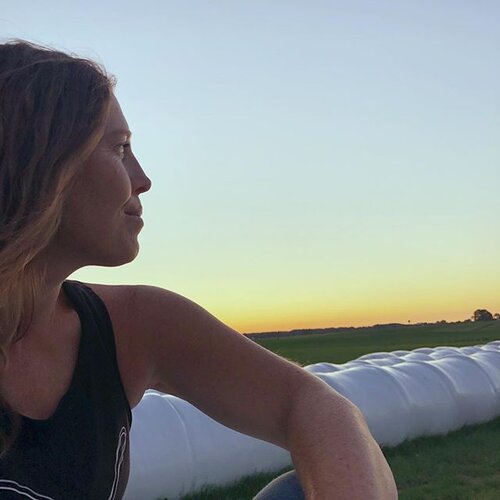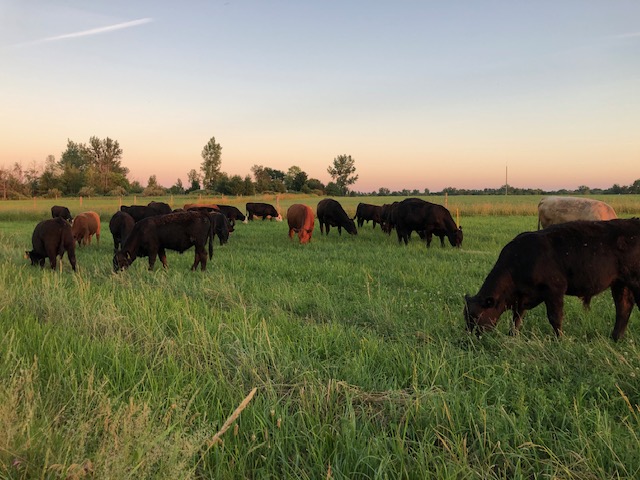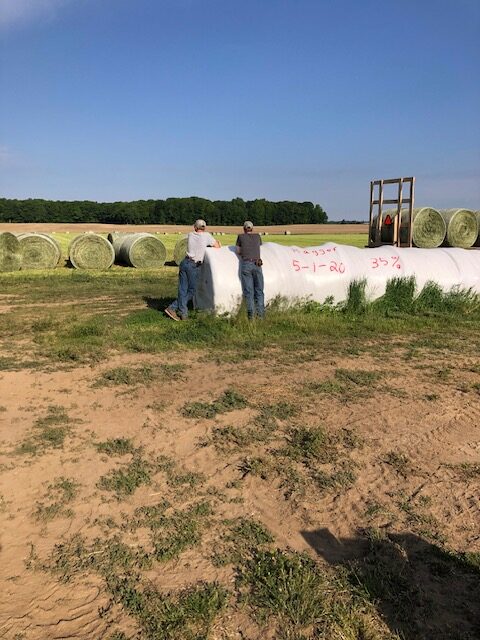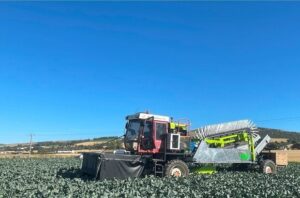
Carla Blog 1.jpeg
How Carla Schultz Handles Meal-Planning for 50 Head of Cattle



Most people know that cattle eat grass and hay. But how do they get the just-right amount of feed that they need all year? It requires planning, plus a contingency for the inevitable in farming: surprises.
Every year, my husband and I crunch numbers to figure out how much hay we need in order to feed our cattle throughout the year. And then, of course, we get surprises throughout the year that impact our feed options. Here’s a glimpse inside how we make it all work to ensure our 50 head of beef cattle are well-fed here at Eight Plate Farms in Mayville, Michigan.
Graze for Four Days
We have a number of our farm fields planted with hay. The bonus about our hay fields here in Michigan is the growth and quality of the hay that we are able to harvest because of larger amounts of rain. Using fence, we set up grazing paddocks1. So, if a particular lot is about twenty acres or so, then we divide the lot into twenty paddocks. We move the cattle into the first paddock and let them graze for four days. Then we move them to the next paddock for four days, and so on. Once the cattle have grazed on the pasture in each paddock, the fresh hay in that first paddock is ready for grazing again.

This process of moving the cattle every four days is called rotational grazing, and it gives us the following benefits:
- Reduced fertilizer applications – The soil is enriched by the cattle manure, which means we are able to utilize the natural manure as compared to spreading commercial fertilizer on these fields. We have other hay fields where the cattle do not graze. Those fields do require more commercial fertilizer when we replant with another crop after four years or so.
- Improved soil health – The recovery of each paddock uses the nutrients from the manure patties and helps the hay grow back to maturity for the next grazing period. Since we do not till our hay fields, worm macropores2 aid in soil aeration. In turn, this fosters faster regrowth because the soil gains more access to oxygen and water.
Fields for Winter Feeding
We have other fields as mentioned above that are not gridded out into paddocks. These are just open hay fields. We go in and cut the hay in these fields during warmer months to store it for cattle feed in the winter months.
There are so many different types of forage options we can plant including orchard grass, fescue, red and white clover, alfalfa, timothy, wheat or rye. The type of hay we choose to plant is dependent on soil type and climate.
Moisture Determines the Meal
Dry hay is difficult to achieve in Michigan because of our consistent rainfall, but it has a desirable dry storage factor that we want for our herd. When hay is cut from the field, it’s already quite wet. In order to get dry hay baled for winter, we have to cut it and let it sit and dry out in the field until the moisture content lowers to 14-18%. Normally we can count on June weather to be rainy while July is dry, but this past year it was flipped. We ended up baling hay that was at 30% moisture in July. Since it was too wet for dry hay, we chose to bale it and wrap groups of 30 bales in big plastic tubes that look like Saran Wrap. This process allows the hay to ferment. If it ferments at the right moisture level, it’s good for the cattle and they love it. This type of fermented hay is called baleage3. We feed it to the cattle while they’re out on pasture or over winter as a free-choice feed4.
Dry Hay Storage
When the weather cooperates and we are able to bale dry hay, we make large round bales and smaller square bales. The large round bales require machinery in order to move them, which for us is typically a spear on a skid steer5. The bales get moved to a barn where we store them with a barrier on the bottom in order to prevent the bales from wicking moisture, which might damage the quality of the hay. We put two round bales of hay side-by-side, then stack a third one on top where it nestles in between the other two. Each bale weighs between 800-1000 lbs. , so they do not roll off.
Hay Math
You’re probably wondering at this point how we make sure that our herd will get the desired amount of feed in the December-May months. It’s a formula that looks something like this:




Source link
2023-12-21 20:00:52
Karl Hoffman is a distinguished agriculturalist with over four decades of experience in sustainable farming practices. He holds a Ph.D. in Agronomy from Cornell University and has made significant contributions as a professor at Iowa State University. Hoffman’s groundbreaking research on integrated pest management and soil health has revolutionized modern agriculture. As a respected farm journalist, his column “Field Notes with Karl Hoffman” and his blog “The Modern Farmer” provide insightful, practical advice to a global audience. Hoffman’s work with the USDA and the United Nations FAO has enhanced food security worldwide. His awards include the USDA’s Distinguished Service Award and the World Food Prize, reflecting his profound impact on agriculture and sustainability.


